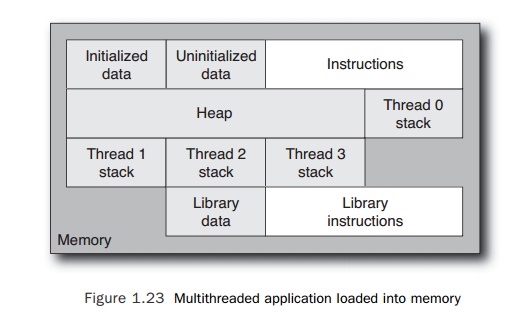Chapter: Multicore Application Programming For Windows, Linux, and Oracle Solaris : Hardware, Processes, and Threads
The Differences Between Processes and Threads
The
Differences Between Processes and Threads
It is
useful to discuss how software is made of both processes and threads and how
these are mapped into memory. This section will introduce some of the concepts,
which will become familiar over the next few chapters. An application comprises
instructions and data. Before it starts running, these are just some
instructions and data laid out on disk, as shown in Figure 1.21.

An
executing application is called a process.
A process is a bit more than instructions and data, since it also has state.
State is the set of values held in the processor registers, the address of the
currently executing instruction, the values held in memory, and any other
values that uniquely define what the process is doing at any moment in time.
The important difference is that as a process runs, its state changes. Figure
1.22 shows the lay-out of an application running in memory.

Processes
are the fundamental building blocks of applications. Multiple applications
running simultaneously are really just multiple processes. Support for multiple
users is typically implemented using multiple processes with different
permissions. Unless the process has been set up to explicitly share state with
another process, all of its state is pri-vate to the process—no other process
can see in. To take a more tangible example, if you run two copies of a text
editor, they both might have a variable current_line, but neither could read the
other one’s value for this variable.
A
particularly critical part of the state for an application is the memory that
has been allocated to it. Recall that memory is allocated using virtual
addresses, so both copies of the hypothetical text editor might have stored the
document at virtual addresses 0x111000 to 0x11a000. Each application will
maintain its own TLB mappings, so identi-cal virtual addresses will map onto
different physical addresses. If one core is running these two applications,
then each application should expect on average to use half the TLB entries for
its mappings—so multiple active processes will end up increasing the pressure
on internal chip structures like the TLBs or caches so that the number of TLB
or cache misses will increase.
Each
process could run multiple threads. A thread has some state, like a process
does, but its state is basically just the values held in its registers plus the
data on its stack. Figure 1.23 shows the memory layout of a multithreaded
application.
A thread
shares a lot of state with other threads in the application. To go back to the
text editor example, as an alternative implementation, there could be a single
text editor application with two windows. Each window would show a different
document, but the

two
documents could no longer both be held at the same virtual address; they would
need different virtual addresses. If the editor application was poorly coded,
activities in one window could cause changes to the data held in the other.
There are
plenty of reasons why someone might choose to write an application that uses
multiple threads. The primary one is that using multiple threads on a system
with multiple hardware threads should produce results faster than a single
thread doing the work. Another reason might be that the problem naturally
decomposes into multiple threads. For example, a web server will have many
simultaneous connections to remote machines, so it is a natural fit to code it
using multiple threads. The other advantage of threads over using multiple
processes is that threads share most of the machine state, in particular the
TLB and cache entries. So if all the threads need to share some data, they can
all read it from the same memory address.
What you
should take away from this discussion is that threads and processes are ways of
getting multiple streams of instructions to coordinate in delivering a solution
to a problem. The advantage of processes is that each process is isolated—if
one process dies, then it can have no impact on other running processes. The
disadvantages of multiple processes is that each process requires its own TLB
entries, which increases the TLB and cache miss rates. The other disadvantage
of using multiple processes is that sharing data between processes requires
explicit control, which can be a costly operation.
Multiple
threads have advantages in low costs of sharing data between threads—one thread
can store an item of data to memory, and that data becomes immediately visible
to all the other threads in that process. The other advantage to sharing is
that all threads share the same TLB and cache entries, so multithreaded
applications can end up with lower cache miss rates. The disadvantage is that
one thread failing will probably cause the entire application to fail.
The same
application can be written either as a multithreaded application or as a multiprocess
application. A good example is the recent changes in web browser design.
Google’s Chrome browser is multiprocess. The browser can use multiple tabs to
display different web pages. Each tab is a separate process, so one tab failing
will not bring down the entire browser. Historically, browsers have been
multithreaded, so if one thread exe-cutes bad code, the whole browser crashes.
Given the unconstrained nature of the Web, it seems a sensible design decision
to aim for robustness rather than low sharing costs.
Related Topics